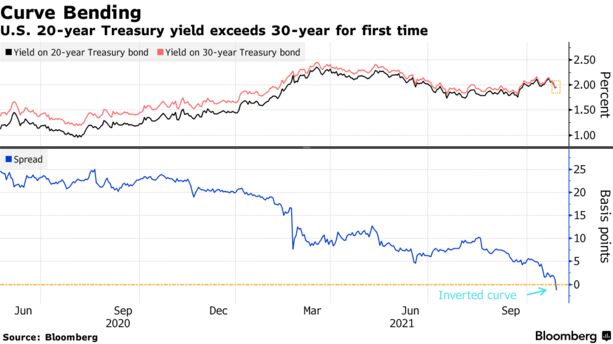
Futures Fall With Stocks; Bonds Extend Declines: Markets Wrap
U.S. futures fell Friday along with European stocks, while traders weighed disappointing earnings and bond-market gyrations sparked by concerns over inflation and monetary tightening.
Contracts on the S&P 500 and Nasdaq 100 retreated as Amazon.com Inc. and Apple Inc. declined in pre-market trading after reporting underwhelming results on Thursday, signaling a possible drop of around $180 billion in combined market value when the U.S. reopens. Starbucks Corp. and Western Digital Corp. were among other companies that dropped after missing analysts’ estimates.
The U.S. 10-year Treasury yield climbed. The curve between 20- and 30-years has inverted for the first time since the U.S. government reintroduced a two-decade maturity in 2020. Inflation pressures and the prospect of interest-rate hikes are whipsawing bond markets. The U.S. dollar ticked up from a one-month low and crude oil fluctuated.
The Stoxx Europe 600 Index pared its fourth straight weekly advance, with technology stocks leading losses. Positive results from companies including Safran SA, Daimler AG and Banco Bilbao Vizcaya Argentaria SA cushioned the decline.

European bonds extended Thursday’s retreat as data on Eurozone economic growth and inflation topped analysts’ estimates, reinforcing growing conviction that interest-rate increases are on the horizon after European Central Bank President Christine Lagarde offered only mild pushback against traders’ bets on a hike as soon as October next year. The euro slipped after jumping 0.7% on Thursday, but remains on track for a third week of gains.
Markets are grappling with a number of crosscurrents. Generally positive corporate performance has helped to underpin global equities. But inflation risks from supply-chain snarls and costlier raw materials are boosting expectations for rate hikes and dimming the economic outlook.
“In the very near term, because many global central banks are just dipping their feet into taper, not even into quantitative tightening, the aggregate liquidity could remain very supportive,” Vishnu Varathan, head of economics and strategy at Mizuho Bank Ltd. in Singapore, said on Bloomberg Television. “Although I think you get very much more discriminatory moves and much more selective moves in the equity markets.”
The latest data showed U.S. growth slowed more than expected in the third quarter, hampered by supply chains and a surge in Covid-19 cases. A separate report showed that weekly jobless claims fell to a pandemic low.
In China, the debt crisis at China Evergrande Group remains in focus. Some holders of one of its bonds received an overdue interest payment, buying more time for the troubled property developer.
Coal futures extended a dramatic decline as China’s government said there’s further room for prices to fall, ratcheting up interventions in the market aimed at easing an energy crisis.
In cryptocurrencies, Bitcoin retreated below $58,000 during a sharp swoon in U.S. trading. The largest token rebounded to around $61,000. Ether, the second largest, rallied to a record high.
Here are some events to watch this week:
- G-20 joint finance and health ministers meeting ahead of the weekend leaders’ summit, Friday
For more market analysis, read our MLIV blog.

These are the main moves in markets:
Stocks
-
Futures on the S&P 500 fell 0.5% as of 7:22 a.m. New York time
-
Futures on the Nasdaq 100 fell 0.9%
-
Futures on the Dow Jones Industrial Average fell 0.1%
-
The Stoxx Europe 600 fell 0.4%
-
The MSCI World index fell 0.2%
Currencies
-
The Bloomberg Dollar Spot Index rose 0.2%
-
The euro fell 0.2% to $1.1653
-
The British pound was little changed at $1.3789
-
The Japanese yen fell 0.2% to 113.77 per dollar
Bonds
-
The yield on 10-year Treasuries advanced two basis points to 1.60%
-
Germany’s 10-year yield advanced five basis points to -0.09%
-
Britain’s 10-year yield advanced three basis points to 1.04%
Commodities
-
West Texas Intermediate crude rose 0.3% to $83.02 a barrel
-
Gold futures fell 0.3% to $1,796.70 an ounce
© 2021 LeackStat.com
